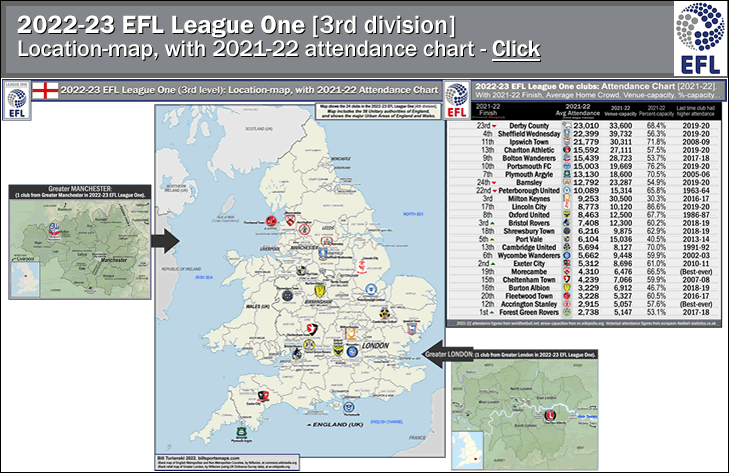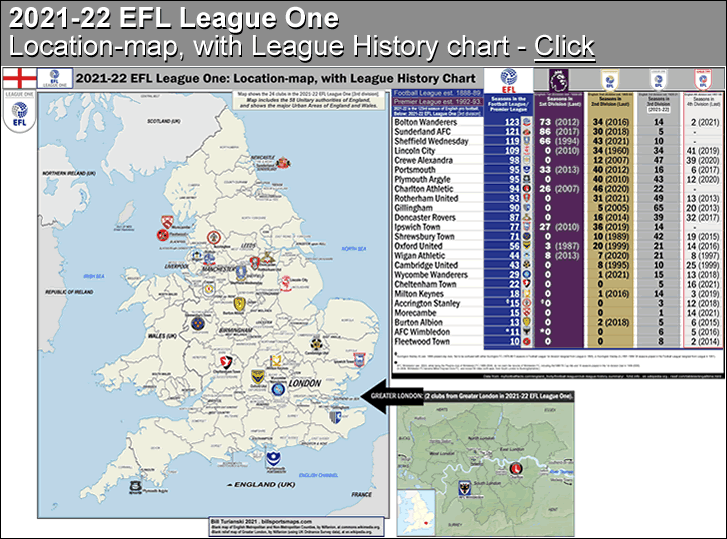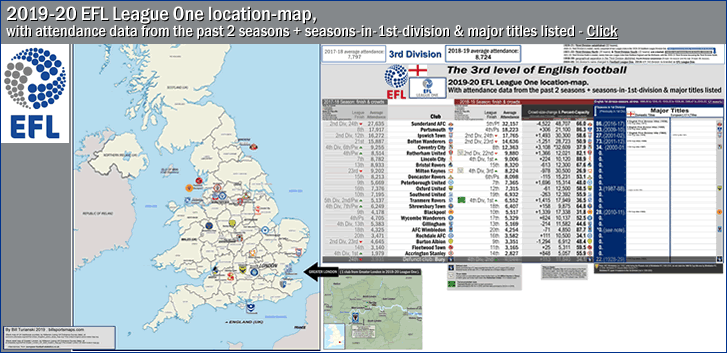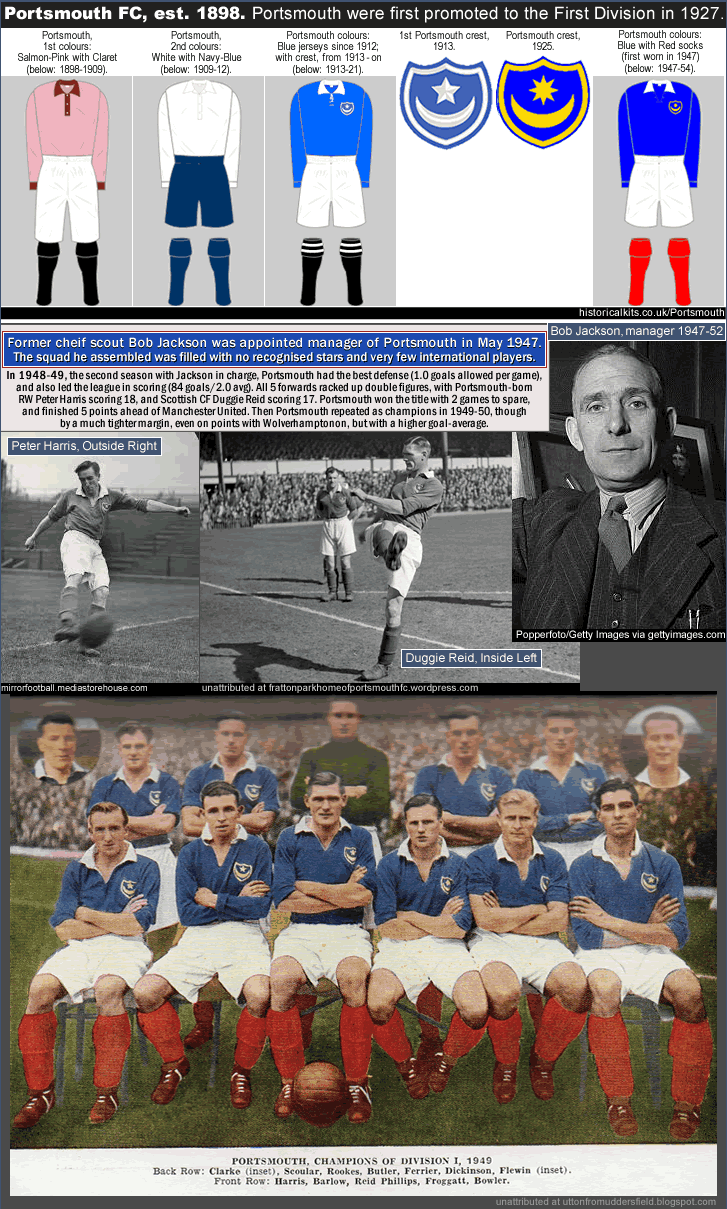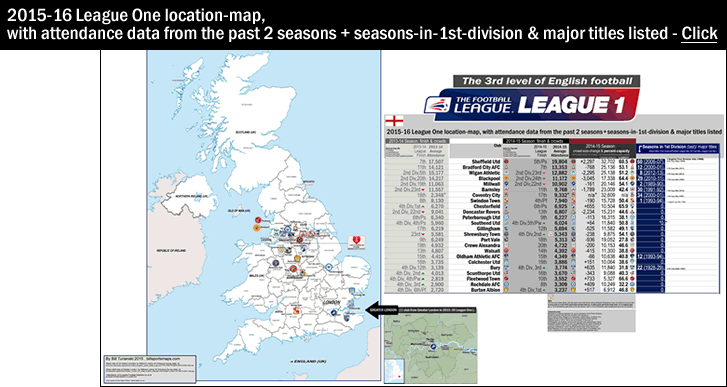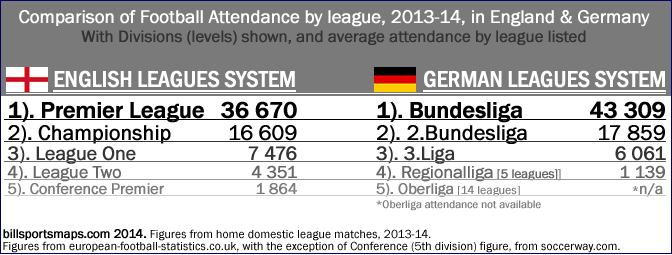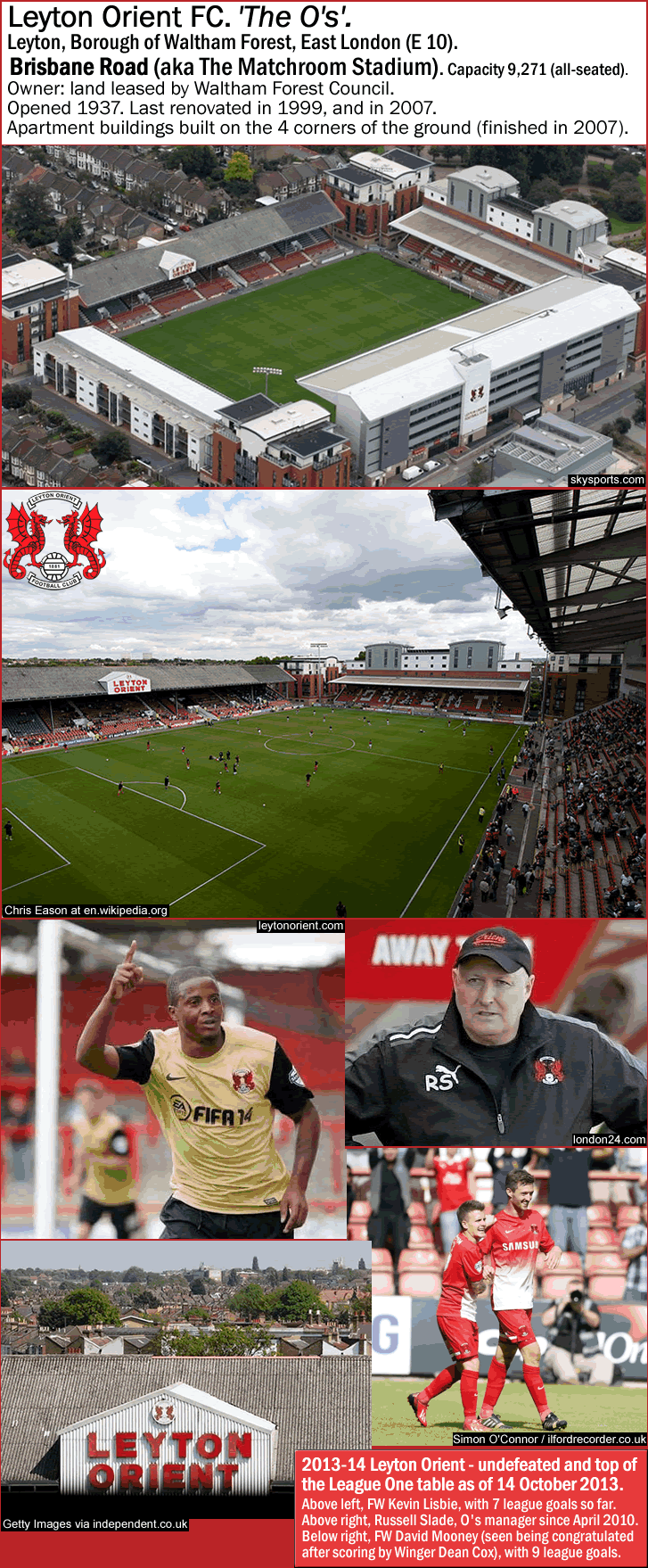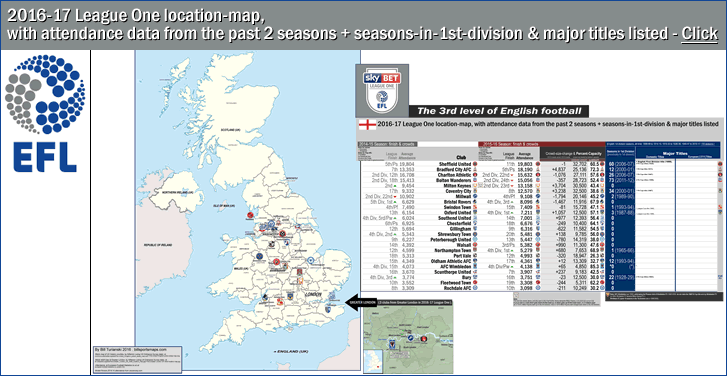
2016–17 Football League One (3rd division England, incl Wales): map w/ 15/16-crowds-&-finish + titles-&-seasons-in-1st-division
…
…
By Bill Turianski on 28 August 2016; twitter.com/billsportsmaps.
Links…
-2016–17 Football League One (en.wikipedia.org).
-Table, fixtures, results, attendance, stats…LEAGUE ONE [Summary] (soccerway.com).
-New font and logos for Football League…2016-17 English Football League [new logos and new font, with branding info] (switchimageproject.blogspot.com).
-Kits…Sky Bet League One 2016 – 2017 [Kits of teams in 16/17 League One] (historicalkits.co.uk).
-Predictions, from a blog which I admire…TTU GO PREDICTING: A CLUB-BY-CLUB LEAGUE 1 PREVIEW 2016-17 (thetwounfortunates.com).
…
Below: illustrations for the 4 promoted clubs for the 2016-17 3rd division…
(Northampton Town, Oxford United, Bristol Rovers, AFC Wimbledon).
• Northampton Town won the 2015-16 League Two by a whopping 13 points and return to the 3rd division for the first time in 7 seasons (the Cobblers’ previous stint in the 3rd division being a 3-season-spell ending in 2008-09).
• Oxford United finished in 2nd place in the 15/16 League Two, and return to the 3rd tier for the first time in 15 seasons (a spell which included 4 years in Non-League football [2007-08 to 2009-10]).
• Back-to-back promoted Bristol Rovers finished 3rd in League Two last season, and are now back in the 3rd division for the first time in 6 seasons (a spell which included one year in Non-League [in 2014-15]).
• And AFC Wimbledon won the 2015-16 League Two play-offs Final (2-0, over Plymouth Argyle), and the 14-year-old supporter-owned club from South West London make their 3rd-division-debut in 2016-17.
…
• Northampton Town FC
Est. 1897. Nickname: the Cobblers. Colours: Claret and White. Location: Northampton, Northamptonshire, situated (by road) 97 km (64 mi) NW of central London; also, Northampton is situated (by road) 87 km (61 mi) SE of Birmingham. Population of Northampton is around 212,000 {2011 census}. Northampton Town are nicknamed the Cobblers because the town was a major centre of shoemaking and other leather industries; the economy in Northampton these days is much-less manufacturing-based, and now more distribution-and-finance-based.
Northampton Town play in a stadium which would seem to have a too-small capacity for a town of its size.
Northampton has a town-population of around 212,000 [2011 census}, yet Northampton Town play at the Sixfields Stadium, which has a capcity of only 7.7 K. That can be explained by the fact that this part of Northamptonshire is rugby-union-county. Rugby union Premiership side Northampton Saints RFC are a 1st division rugby team which vastly outdraws Northampton Town, and whose stadium is more than twice the size of the Cobblers' ground. The Saints rugby union club draws around 10-to-12 K, versus the 4.2-to-6.0-K which the Cobblers have drawn since they moved in to Sixfields in 1994-95. (Northampton Town drew 5.2 K last season [2015-16].)
Northampton Town have been primarily a lower-Leagues club, with 89 seasons spent in the Football League [first in 1920-21], all but four seasons of which have been spent either in the 3rd division [with 48 seasons including 2016-17], or in the 4th division [with 38 seasons]. {NTFC League history, here.} (Note: there is an article on the single season Northampton Town spent in the First Division, 1965-66, further below.)
Manager of Northampton Town:
Rob Page (age 41), born in Llwynypia, Rhondda Valley, South Wales. Rob Page, as a player, was a defender who made 104 league appearances for Sheffield United (2001-04) and 70 league appearances for Coventry City (2005-08), as well as 41 appearances for the Wales national team (1996-2005). Page came over to Northampton Town after a one-and-two-thirds-seasons stint as manager of Port Vale (with 3rd-division finishes of 18th and 12th).
Rob Page replaced Chris Wilder.
Chris Wilder had got Northampton Town promoted as League Two champions in May 2016. That was after Wilder had left the 6th-place-Oxford United in January 2015, and joined bottom-of-the-table Northampton Town. It seemed to be a head-scratcher as to why Wilder would leave a bigger and higher-placed club (Oxford), for a club like Northampton, which looked doomed to be relegated to the Conference. As the BBC said {here}, “…people will question the Wilder move”… Ha! The question actually ended up being this…Why hasn’t any bigger club noticed how solid a manager Chris Wilder is? Of course I say that now with the luxury of hindsight, because Wilder kept the all-but-relegated Northampton Town up in the spring of 2015, moving them half-way up the table to a solid 12th-place finish. Then the following season, Wilder led the cash-strapped Cobblers to automatic promotion to League One. Northampton Town simply cruised to the league title, finishing 13 points higher than the 2nd-place-finishers, Wilder’s former club, Oxford United. Then finally, a bigger club noticed, and in June of 2016, Wilder signed on as the manager of arguably the biggest club currently in the 3rd tier, Sheffield United.
Four standout players on the 2016-16 Northampton squad…
Further below can be seen the two top offensive threats for Northampton Town in 2016-17 – Ricky Holmes & Marc Richards. Ricky Holmes led the team in assists (with 10 assists in league games), and scored 9 league goals as well, and was one of three Cobblers players selected for the 2015-16 League Two Team of the Year {see this}. In June 2016, Holmes was transferred to Charlton for a fee of £675,000. Marc Richards, in his second stint with the Cobblers, is age 34. Richards led the Cobblers with 15 league goals last season. Richards still starts for Northampton Town, as of August of the 2016-17 season. Also still in the Cobblers’ squad as of August 2016-17 are two more players shown below. Both were also selected to the Team of the Year: goalkeeper Adam Smith (age 23), and the Northampton Town Player of the Year, John-Joe O’Toole. O’Toole is a cult hero at Town, and is a scrappy 27-year-old attacking midfielder who scored 12 league goals (plus 2 assists) in 15/16.

Photo and Image credits above -
NTFC 16/17 jersey, photo by footballshirtculture.com/16/17-Kits/northampton-town. The Drapery (Northampton town centre), photo by Gordon Cragg/Geograph.org via bbc.co.uk. Exterior photo of Sixfields from ridge above stadium, photo unattributed at footballtripper.com. Photo of Ricky Holmes and Marc Richards celebrating their teams’ promotion at Sixfields (with bubbly), photo by Pete Norton /Getty Images via gettyimages.com. Photo of Adam Smith, photo by Pete Norton/Getty Images Europe via zimbio.com. Photo of John-Joe O’Toole, photo by Northampton Chronicle and Echo at northamptonchron.co.uk.
…
Article:
Northampton Town’s meteoric decade of the 1960s, with 3 promotions & 3 relegations in a 9-season span…
From 1960-61 to 1968-69, the Cobblers had a stunning and meteoric 9-season-/-3-promotions-/-then-3-relegations rise and fall. During this period, Northampton played their solitary season in the First Division. That was in 1965-66, when Northampton Town finished 21st out of 22, and went straight back down. Then they were relegated twice more in three seasons, and by 1969-70, the Cobblers were right back where they started the decade, in the basement of the Football League. The man who was most responsible for getting Northampton Town in to the top flight for that solitary season was Dave Bowen. Dave Bowen was born in Maesteg, Glamorgan, South Wales. He was in training as a collier at 17 when his family moved to Northamptonshire. Bowen joined the Northampton Town set-up in 1947, as a 19-year-old, and by 1950 he had made 12 appearances for the senior squad. In 1950, during National Service duties with the RAF, Bowen met Pat Whittaker, the son of Arsenal manager George. That led to his signing with Arsenal, and Bowen went on to play for the Gunners for 9 seasons as a defensive midfielder (Wing Half), and later, as the Arsenal team captain (1957-59). (Dave Bowen also captained Wales when they qualified for and then played in the 1958 FIFA World Cup in Brazil.) After 146 league appearances for Arsenal, Bowen returned to Northampton Town, in 1959-60, as player/manager (he retired from the field in 1961).
In Dave Bowen’s second season managing Northampton Town, in 1960-61, the Cobblers won promotion to the Third Division…
By this time, Bowen was becoming known as a canny manager who could assemble a very competent squad on a shoestring budget. Bowen was also becoming a great locker-room motivator. Two seasons later, in 1962-63, Northampton were positively rampant, scoring 109 goals (in 42 games, making for an astounding 2.59 goals-scored-per-game ). Northampton Town won the Third Division title that season, finishing 4 points above Swindon Town (and with a +48 goal difference). In 1963-64, Northampton Town made their Second Division debut, finishing a credible 11th. The following season, 1964-65, propelled by a mid-season 17-match unbeaten run, Northampton clinched an improbable promotion to the top flight, finishing in 2nd place, 2 points behind Newcastle United. Further below, in the first illustration, you can see a colour-photo from May of 1965 at the County Cricket Ground (where Northampton Town played for 97 years [1897-1994]). In the photo below, the just-promoted Northampton team are saluting their fans with a Thank You banner, as they take a victory lap of sorts. I say “a victory lap of sorts”, because the County Cricket Ground was one of the more odd Football League venues. It was a dual-football-cricket-venue, and for football it had stands on only 3 sides and a wide swath of grass (to complete the cricket-field) on the fourth side {see this photo}.
Here is a great, and recent article about 1960s-era Northampton Town…from The Football Pink.net, from 19 October 2015, by Mark Godfrey, What a load of Cobblers! (footballpink.net).
1965-66: Northampton’s fairy tale season in the First Division started out more like a nightmare, as they went win-less in their first 14 matches…
In 1965-66, the Cobblers were pretty much out of their league in the First Division, and heavy defeats would come at the hands of Everton, Leeds United, Blackburn Rovers, Liverpool, Manchester United, and Stoke City. But they finally got their first win on 23 October 1965, over West Ham United, and as mid-season approached, the team had acclimated, and began to mount a relegation battle. Along the way they set a club-record for home attendance – with a 24,523 crowd at the County Cricket Ground, in a loss versus Fulham in late April 1966. A win against Sunderland the following week didn’t change the fact that the Cobblers now needed other results to go their way, and the Cobblers conceded relegation on the last game of the season. One small solace was that they had won both derby matches against nearby Aston Villa (located about 60 miles west). A notable achievement in Northampton Town’s 1965-66 season was made by Cobblers FW Barry Lines (1960-69), who became the first player ever to score in all four divisions of the Football League for the same club. Though, granted, the Fourth Division had been instituted just 7 seasons earlier (in 1958-59.)
Following relegation from the First Division in May 1966, Northampton would get relegated again the next May (1967), and two seasons later another relegation in May of 1969 would find them back in the Fourth Division. Since then, Northampton Town have never again been in the 2nd division, let alone in the top flight. And no club in the English football pyramid has ever come close to going the 3-promotions-then-3-relegations route in so short a time as in the 9 years it took Northampton Town to do so. As it says in the article by Mark Godfrey linked to 3 paragraphs above {or here}…”In English football, only Swansea City come close to matching this ‘achievement’. The Swans’ rise and fall was encompassed neatly within sixteen years between 1970 and 1986. [And] Carlisle United did it in twenty-two years between 1964 and 1987.”

Photo and Image credits above –
Image of 1960s-era Lilywhite postcard [of The Drapery section of Northampton town centre circa 1960s], image uploaded by Kevin Lane at flickr.com. Photo of 1964-67 Northampton Town retro jersey, by Toffs at toffs.com. Photo of Dave Bowen [as Arsenal player in the late 1950s], photo by Arsenal FC at arsenal.com/history/profiles/dave-bowen. Illustration of Arsenal 1947-57 kit, illustration by historicalkits.co.uk/Arsenal. 1962-63 Northampton Town Third Division team, photo by Bob Thomas/Popperphoto via Getty Images via gettyimages.co.uk. Illustration of Northampton Town 1965-66 kit, illustration by historicalkits.co.uk/Northampton_Town. Photo of Northampton Town squad in front of airplane which would fly them to their first First Division match in Plymouth, photo unattributed at footballpink.net/what-a-load-of-cobblers-northampton-towns-class-of-66; from the book Northampton Town: A Season in the Sun (1965-66), by Mark Beesely {here}. Color photo of 1964-65 Northampton squad parading a Thank You banner to the fans, at the old County Cricket Ground [circa May 1965], photo by Bob Thomas/Popperphoto via gettyimages.co.uk. Team-photo of 1965-66 Northampton Town squad, photo unattributed at footballpink.net/what-a-load-of-cobblers-northampton-towns-class-of-66; from the book Northampton Town: A Season in the Sun (1965-66), by Mark Beesely {here}.
…
• Oxford United FC
Est. 1893, as Headington United. Nickname: the U’s. Colours: Yellow and Oxford Blue [Navy Blue]. Location: Oxford, Oxfordshire, situated (by road) 95 km (59 mi) WNW of central London; also, Oxford is situated (by road) 48 km (30 mi) NE of hated rivals Swindon. Population (city-population of Oxford is around 159,000 {2013 estimate}; the metro-area-population of Oxford is around 244,000 {2011 census}. (Oxford is the 52nd-largest city in the United Kingdom {2013 figure}.)
Oxford United League history {here} (oxfordunited-mad.co.uk).
Manager of Oxford United:
Michael Appleton (age 40), born in Salford [which is now part of Greater Manchester]. By getting Oxford United their long-sought-after promotion back to the 3rd division, Michael Appleton helped to restore his reputation as an up-and-coming manager. A defender in his playing days, Appleton had made 121 league appearances for Preston North End (1997-2001). Appleton then moved on to West Bromwich Albion, but he ended up making only 31 league appearances for the West Midlands side. Appleton was forced to retire early, in 2003, after a knee injury – and then a botched knee-operation – which he had suffered two years before. After retirement, he remained with the Baggies, coaching the WBA youth set-up for 5 years. In 2009, he became part of the West Bromwich senior squad’s coaching staff. Appleton began to get a reputation as a solid judge of talent, and a young coach with potential. In November of 2011, Appleton got his first shot at a manager’s job, when he was hired by then-2nd-division side Portsmouth. But the Portsmouth manager job at that point in time was no plum position. That was because Pompey were in their protracted supporter-takeover process, and the club was hampered by a no-cash-flow-situation, ongoing court-cases, and the looming threat of relegation(s) due to points-deduction. Portsmouth did get relegated from the 2nd division that season [2011-12], but the penalty of a 10-points-deduction (due to falling into administration) was the real culprit there (Portsmouth finished 8 points below the drop).
The next season, in November 2012, Appleton sort of left Portsmouth twisting in the wind, when he jumped ship and signed on as manager of then-2nd-division-side Blackpool. This move would backfire on Appleton, seeing as how Blackpool were (and still are) run by the divisive Oystons. Appleton lasted just 11 league games for the now-stuck-in-the-4th-division-Blackpool, resigning in January 2013. Then Appleton was able to win the Blackburn Rovers manager’s position, but, again, Appleton walked into a set-up where the ownership was severely at loggerheads with the bulk of the home-support. The owners of Blackburn Rovers were and still are the Venky’s chicken-processing conglomerate. An example of how clueless the folks who run Blackburn Rovers are is this…when they bought the then-Premier-League club Blackburn Rovers, the chicken-kings from Pune, India did not even know that clubs in England (like Blackburn) could actually get relegated. They thought they were buying a franchise which would always stay in the top flight (seriously). But I digress. Appleton barely lasted 2 months with the probably-going-nowhere-but-down Blackburn, then he was sacked in March 2013.
Oxford United hires Michael Appleton prior to the 2014-15 season…
But, 15 months later, in June 2014, Appleton got another shot, and was hired as Oxford United manager. In his first season in charge, Appleton’s Oxford United had a mediocre 14th-place finish [in 2014-15]. The following season, however, Appleton got Oxford promoted, as the U’s finished in 2nd place, after spending most of the season in the automatic promotion places. And so Oxford United had returned to the 3rd division after a 16-year absence. As Appleton told BBC {here}, “There’s a lot of people who say you can’t get out of this league playing decent football, but I’d go as far as to say you can get out of this league doing that and this is just the start of it.”
Last season, second-place finishers Oxford United led the 4th division in scoring, with 84 goals, as well as having best goal-difference (of +43). And the U’s lost just one of their final 10 games. Two Oxford players were selected to the 2015-16 League Two Team of the Year…the on-loan defender George Baldock and midfielder Kemar Roofe. But neither are with Oxford for 2016-17, as Baldock has rejoined Milton Keynes, and Kemar Roofe (who was also selected as League Two Player of the Year/see him below) was sold to Leeds United in the summer of 2016 for a fee of £3 million. One standout player for Oxford United who will return for 2016-17 is the 26-year-old midfielder Liam Sercombe (see him below).

Photo and Image credits above –
16/17 Oxford United jersey, photo unattributed at footballkitnews.com
Oxford skyline shot at golden-twilight, photo by Dillif at File: Oxford Skyline Panorama from St Mary’s Church – Oct. 2006. View of Oxford near the town centre, photo by Lauren Meshkin at bonvoyagelauren.com/photo-essay-a-sunny-day-in-oxford-england. Aerial view of the Kassam Stadium, photo by Dave Price at geograph.org. Photo of Kemar Roofe, photo by AFP/Getty Images via mirror.co.uk/football. Photo of Liam Sercombe, photo by the Oxford Times at oxfordtimes.co.uk/sport. Screenshot of Michael Appleton being congratulated by supporters after Oxford clinched promotion [last game of 2015-126 season], image from video at bbc.com/football.
…
• Bristol Rovers FC
Est. 1893, as Black Arabs FC. Nickname: the Black Pirates; BRFC are also nicknamed the Gas (so-named, because Bristol Rovers’ old ground, Eastville Stadium [BRFC played there from 1897 to 1986] was located next to an odiferous natural gas-holding facility [aka a gasometer]). Colours: Pale-Royal-Blue and White Quarters. Location: Horfield, a northern ward in the Bristol Unitary Authority, situated (by road) 190 km (118 mi) W of central London; also, Bristol is situated (by road) 22 km (14 mi) NW of Bath. Population: city/unitary-authority-[county]-population of Bristol is around 449,000 {2015 estimate}; the metro-area-population of Bristol is around 1 million {2009 estimate}. Bristol is the 8th-largest city in the United Kingdom.
Bristol Rovers League history {here} (bristolrovers-mad.co.uk).
Manager of Bristol Rovers:
Darrell Clarke (age 37), born in Mansfield, Nottinghamshire. Clarke was appointed manager of the floundering Bristol Rovers in March of 2014, after then-manager John Ward stepped down and was appointed Director Football there. Clarke could do nothing to reverse Bristol Rovers’ fortunes that season (they were relegated out of the Football League on the final day of the 14/15 season). But Darrell Clarke stayed on with Bristol Rovers as they made their 5th-division debut, and the Rovers reversed the recent trend of League teams being stuck in the Non-League Wilderness, by winning automatic promotion straight back to the 4th division. As it says in his Wikipedia page,”[Darrell Clarke] oversaw a rapid turnover of players for the 2014–15 season, releasing 16 players and signing 13 players on free transfers, including striker Matty Taylor. After a poor start Rovers rose up the table and ended the campaign in second place, one point behind Barnet. Clarke led Rovers to promotion with a 5–3 penalty shoot-out victory over Grimsby Town at Wembley Stadium in the 2015 Conference Premier play-off Final on 17 May 2015, after a 1–1 draw after extra time. He won three Manager of the Month awards during the season, in September, December and February”. Then Darrell Clarke led the Bristol Rovers to a second-straight promotion the following season of 2015-16 (more on that below).
Bristol Rovers FW Matt Taylor led the 2015-16 League Two in scoring (with 27 league-goals)….
Last season, the 25-year-old former-Chester-and-former-Forest-Green striker Matty Taylor scored 28 goals in all competitions for Bristol Rovers, as the north Bristol side claimed 3rd place, and the last automatic promotion spot, in the 15/16 League Two. Even on points, Bristol Rovers ended up beating out poor-old Accrington Stanley, on goal difference {table}. (Then, of course, Stanley lost in the play-offs.) Bristol Rovers secured their promotion only in the 92nd minute of the final game, which was a 2-1 home win over Dagenham & Redbridge, before a near-full-capacity crowd of 11,130, at the Memorial Stadium in Horfield, Bristol. The winning and promotion-clinching goal was scored by Rovers defender Lee Brown, off of a rebound off the goal-post, from a shot by Matty Taylor (see fuzzy screenshots below). Then there was a massive pitch invasion by the Gas faithful (see it further below). A few months later, Taylor signed a new deal with the Gas. Bristol Rovers, led by young manager Darrell Clarke, have now achieved back-to-back promotions. Three-peat, anyone? Up the Gas !

Photo and Image credits above -
16/17 Bristol Rovers jersey, photo by brfcdirect.co.uk/Bristol-Rovers-Home-Shirt-2016-17. Aerial view of Clifton Suspension Bridge, photo by Harris Aerial Images at harrisaerialimages.com. Street-view shot of Gloucester Road in Horfield, Bristol, photo by weirdoldhattie at File:A38 Gloucester Road Bristol.jpg (commons.wikimedia.org). Roof-top view of Memorial Stadium, photo unattributed at worldrugbymuseumblog.wordpress.com. Terrace-view of looming Main Stand at Memorial Stadium, photo by groundhopperunited.com/ [April 2012] memorial-stadium. Matty Taylor, photo by Rex Features via bbc.com/football. Screenshot of promotion clinching goal for BRFC: 1st image and 2nd image from youtube.com video uploaded by jedi gas at BRISTOL ROVERS 2 V DAGENHAM & REDBRIDGE 1..7 May 2016. Bristol Rovers fans’ pitch invasion of 7 May 2016, photo by Bristol Post at bristolpost.co.uk/fans-hold-street-party-celebrate-bristol-rovers. BRFC manager Darrell Clarke celebrating back-to-back promotions with the Gas faithful, photo by JMP/REX/Shutterstock via dailymail.co.uk/sport/football. Lee Brown, carried off the field by BRFC fans, photo by Press Association (PA) via dailymail.co.uk/sport/football.
…
• AFC Wimbledon
Est. 2002. Nickname: the Wombles; the [original] Dons. Colours: Royal Blue with Yellow trim. Location: Kingston upon Thames, South West London.
Manager of AFC Wimbledon:
Neil Ardley (age 43), born in Epsom, Surrey. Ardley played as a right-back/defensive-midfielder for Wimbledon FC for 11 seasons (from 1991-2002, making 245 league appearances and scoring 18 goals). He also made 111 league appearances for Watford, had a season with Cardiff City, and finished his playing career with Millwall in 2006-07. He began his coaching career in 2007, and he ran the Cardiff City youth set-up for 5 years. He was hired by AFC Wimbledon in October 2012, when the club, who were at that time in their second season in the Football League, were in a very precarious position, sitting just above the relegation zone. Ardley then proceeded to guide AFC Wimbledon marginally up the table and away from the drop, but only just – it wasn’t until the final day of the 12/13 League Two season that they avoided relegation, by a point (Barnet and Aldershot went down that year). After that, Ardley led AFC Wimbledon to 4th-tier finishes of 20th, 15th, and then to 7th last season, when they qualified for the final play-off spot. Then they caught fire and won the 2016 League Two play-offs (see below/ you can see Neil Ardley in the centre of the 5th photo below). Lyle Taylor was Wimbledon’s leading scorer in 2015-16, netting 22 league goals. The Greenwich, South East London-born and Montserrat-international Taylor also came through in the play-offs, scoring the-go-ahead goal in aet of the 2nd leg of the semi-finals (versus Accrington). And then Lyle Taylor scored the first goal in the Final at Wembley (versus Plymouth). George Francombe led AFC Wimbledon last season with 11 assists in league games (plus he scored 3 goals). Another play-offs-goal-scoring-hero, Adebayo Akinfenwa (aka Beast Mode), has moved on to 4th-tier side Wycombe.
Below are all the goal-scorers in the 2016 League Two play-offs for Wimbledon…

Photo of Tom Beere scoring in play-offs 1st R/1st leg, photo by BPI/Rex/Shutterstock via theguardian.com/football. Photo of Adebayo Akinfenwa after scoring in play-offs 1st R/2nd leg, photo by Getty Images via dailymail.co.uk/football. Photo of Lyle Taylor being carried on shoulders of fans following win, photo by Getty Images via dailymail.co.uk/football. Photo of Lyle Taylor scoring in Play-offs Final, photo by REX/Shutterstock via mirror.co.uk/football. Photo of Neil Ardley about to congratulated Lyle Taylor for scoring in the Final, photo unattributed at fourfourtwo.com. Photo of Adebayo Akinfenwa scoring a penalty kick, photo by Matthew Aston/AMA/Getty Images via theguardian.com/football. Photo of AFC Wimbledon squad celebrating at the podium, photo unattributed at mirror.co.uk/football.
…
Current location of AFC Wimbledon, and the location of the new stadium the club plans to build (back in their spiritual home in Wimbledon)…

Image credit above – Map by billsportsmaps.com/blank relief map of Greater London, by Nilfanion at File:Greater London UK relief location map.jpg.
AFC Wimbledon currently play at Kingsmeadow [aka the Cherry Red Records Stadium], which is located in the Norbiton area of Kingston upon Thames, South West London. (The Norbiton area of Kingston upon Thames is located 18 km (11 mi) SW of central London.) Kingsmeadow has a capacity 4,850 (2,265 seated), and opened in 1989. The original owner of the ground was the 7th division club Kingstonian FC, and they still play there. AFC Wimbledon bought the ground from Kingstonian in 2003, with very favourable lease-terms for Kingstonian {see this}. Kingsmeadow is about 7 miles west of where Wimbledon FC played, at the old Plough Lane (tumblr.com). The spiritual home of AFC Wimbledon is Wimbledon, borough of Merton, South-West London. AFC Wimbledon intend to move back to the Wimbledon area, into a purpose-built stadium, and plans were well underway for that. (Note: you can see the site of the proposed new stadium on the map above). But then the mayor of London (at the time), Boris Johnson, tried to scuttle it in the early spring of 2016 (he is a kill-joy Tory, after all). But a reprieve has come in the shape of London’s new mayor – Sadiq Khan (take that, Brexit voters – a Muslim is going to save AFC Wimbledon’s new stadium). See this, from 22 August 2016, AFC Wimbledon: Sadiq Khan returns Plough Lane stadium decision to Merton Council (bbc.com/football).
-{Also see this, ‘All systems go’: Sadiq Khan hands back Plough Lane AFC Wimbledon stadium decision to Merton Council (yourlocalguardian.co.uk).}
-{Also see this, London mayor backs AFC Wimbledon’s plans for Plough Lane return (PA article via espnfc.com).}
Update: [from 15 September 2016]: Council stands by AFC Wimbledon decision; excerpt: ” The cross-party planning committee noted the Mayor’s decision and the unanimous decision it made in December 2015 to give the go-ahead to AFC Wimbledon and Galliard Homes. Officers will now finalise the planning process of completing legal agreements and look forward to progressing delivery on site. The council has always been adamant that the Plough Lane site should be for sporting intensification. The new development will eventually comprise over 600 much-needed new homes, a 20,000 seater stadium, retail space, a squash and fitness club, car and cycle parking.” (news.merton.gov.uk).
Below is a photo of the Raynes Park neighborhood of Wimbledon in the London borough of Merton; and an old [circa-late-1980s] photo of old Plough Lane; and an exterior-shot and a small panoramic shot of Kingsmeadow; plus a bunch of photos of present-day fans of the club: AFC Wimbledon supporters at the 2016 League Two play-offs semi-finals match at Kingsmeadow [photos from 14 May 2016 match of AFC Wimbledon 1-0 Accrington Stanley. Attendance: an overflow and record-setting crowd of 4,870].

Photo and Image credits above -
Photo of 16/17 AFC Wimbledon jersey, photo unattributed at footballkitnews.com. Photo of river-side view of Kingston Bridge and Railway Bridge in Kingston upon Thames, Greater London, photo by Alan McFadden {here} at britainfromabove.org.uk. Photo of the Raynes Park Tavern in Wimbledon, borough of Merton, photo by Stuart Smith at panoramio.com. Circa-1980s shot of Plough Lane, photo by Getty Images via bbc.com/sport/football. Photo of entrance to Kingsmeadow, photo by phildanmatt.weebly.com/afc-wimbledon. Photo of Kingsmeadow (panorama of interior), photo by Groundhopping The Globe! site at phildanmatt.weebly.com/afc-wimbledon. The 8 photos of AFC Wimbledon fans are by Louis Darling at GetWestLondon.co.uk at: getwestlondon.co.uk/sport/football/football-news/afc-wimbledon-1-0-accrington [Gallery].
…
Article:
AFC Wimbledon were established as a wholly-supporter-owned Protest-club of Wimbledon FC, in 2002…
{See these quotes from, Relocation of Wimbledon F.C. to Milton Keynes, which points out this…” the Milton Keynes Development Corporation envisaged a stadium in the town hosting top-flight football and was keen on the idea of an established League team relocating there.”…, and which begins with this sentence…”Wimbledon Football Club relocated to Milton Keynes in September 2003, 16 months after receiving permission to do so from an independent commission appointed by the Football Association.” (en.wikipedia.org).}
So the question is…Why didn’t Wimbledon FC-owner/Milton Keynes FC-owner Pete Winkelman just buy an existing club in the Milton Keynes area and then try to move them up the football leagues ladder, like AFC Wimbledon later did, and, you know, like every other club in the history of English football has done? The answer is that Pete Winkelman felt he was entitled to contravene over one hundred years of tradition and behavior, and take a club away from its supporters, simply because he could (and because it was easier)… and then 2 of the 3 guys that the FA entrusted to make a decision on this, one of whom is a lawyer (solicitor), agreed, because in their infamous words, keeping Wimbledon FC in South London where all their fans were was “not in the wider interests of football”.
In 2002, after Wimbledon FC had been taken over by outside interests (Winkelman and company), the new ownership essentially turned the original Wimbledon FC into a franchise. They did this by moving the club (against the wishes of virtually all its supporters), 56 miles north, to the New-town of Milton Keynes in Buckinghamshire, as Milton Keynes FC (aka McFranchise; aka the McDons) (est 2004). In other words, Milton Keynes stole Wimbledon’s team AND their League-place. So the football authorities let outside interests steal Wimbledon FC from their supporters, and the football authorities gave their approval for the League-placement-theft – by Milton Keynes – of Wimbledon’s League-place. You might say Wimbledon FC was not worth much circa 2002 – as the club was basically homeless and in considerable debt. But Wimbledon FC’s League-place? Well, that was (and still is) priceless. Because anyone can start a football club in England (and they still do). But to start a football club, in England, means that the football authorities (the FA) will place that new club way down in the nether-reaches of the football pyramid. Like in the 7th level or the 8th level or the 9th level (which was where AFC Wimbledon started out, in 2002-03). But the FA, in 2002, basically let Milton Keynes circumvent this, as Wimbledon FC became Milton Keynes FC…and thus, suddenly, Milton Keynes had a club in the Football League. Without playing their way up the ladder. And by “re-locating” someone else’s club.
All the money in the world does not get you a Football League club. You have to earn it, on the field, by winning enough promotions, until you arrive into the 4th division. Now granted, prior to 1986-87, Non-League clubs did not play their way into the League per se, because before 1986-87, there was no automatic promotion between Non-League football and the 92-team/4-division Football League. As it says in the link at the top of this section (again, {here}), “The bottom four clubs [in the 4th division] had to apply for re-election by the other member clubs at the end of each season, alongside any non-League teams who wished to take their place.” The bottom clubs of the lowest Football League division had to go ‘cap-in-hand’ to the General Meeting of the Football League each off-season, and endure a vote by their Football League colleagues, who also considered the applications of ambitious Non-League clubs eager to join the Football League.
So clubs in this era (1888-89 to 1985-86) still did have to earn it, because all the Football League clubs each off-season would only elect Non-League clubs into the League which (in their minds) did have the merit…the merit to cut it in the Football League. And if clubs couldn’t cut it in the League, they would get voted out in due time. And in the latter stages of the election-for-promotion/relegation format, indeed in all the post-War years, very few Non-League clubs were being elected into the League, and most seasons no clubs were being elected – at all – into the League. To see how hard it was, take a look at the chart in the following link, {here, Promotion to/Relegation from the Football League by year (thepyramid.info)}, which shows that in the last 40 seasons of the Football League’s election-for-promotion/relegation format (1946-47 to 1985-86), only 7 clubs were elected into the Football League (Workington elected in, 1951; Peterborough Utd elected in, 1960; Oxford Utd elected in, 1962; Cambridge Utd elected in, 1972; Hereford Utd elected in, 1972; Wimbledon FC elected in, 1977; Wigan Athletic elected in, 1978). That’s it…7 Non-League clubs elected in to the Football League in the last 40 seasons of the election-for-promotion/relegation format. That means that for 4 decades, only 17 percent of the time was there even one solitary Non-League club allowed in to join the League. That is how hard it was, back then, to get into the Football League.
It has always been very tough to get into the Football League. Then the rules changed in 1986-87, and the top division of Non-League football (the 5th division) was given an automatic promotion-place. Since 1986-87, a club truly does have to play their way in to the Football League. And that should have been when the Milton Keynes Development Council (which was still in existence, and existed until 1992), and by extension, the Milton Keynes town leaders, should have stopped trying to “re-locate” (ie, steal) other fans’ League clubs. Because after 1986, Non-League clubs could now play their way into the Football League. (Besides having first tried to “re-locate” / read: steal Wimbledon FC in the late 1970s, the Milton Keynes Development Commission had tried to “re-locate” [steal] Charlton Athletic in the early 1970s, and then they had tried to “re-locate” [steal] Luton Town in the mid-1980s {see, again, the second paragraph here}.) But no, the town fathers running Milton Keynes still felt they could only get a Football League team if they STOLE ONE. Forget about investing in local Milton Keynes/Bucks/Bedfordshire lower-Non-League football clubs like Bletchley Town [now defunct], or Wolverton Town & B.R. [now defunct], or Stony Stratford Town, or New Bradwell St Peter, or Newport Pagnell Wanderers (Newport Pagnell Town from 1972). No, those people running things in that new-town 45 miles north of London decided they would rather not invest in any of the aforementioned local football clubs (not very civic-minded of them). Instead, circa the late 1980s and onward, the movers and shakers of Milton Keynes decided they would still rather try to nick a pre-existing League club. Less bother for them (or so they thought). So it’s not just that Milton Keynes “re-located” (read: stole) a football club from South London. That is a crime in itself. But the real crime is that Milton Keynes stole something priceless…a hard-earned place in the Football League. End of.
And so in early 2002, the heartbroken supporters of Wimbledon FC said, “Sod it, let’s just form our own club.”
And they did. They formed AFC Wimbledon, and they put up flyers on signposts in the area announcing an open tryout for players, on the Common in Wimbledon (true story). Then, essentially skint, the supporters who ran and owned the threadbare-but-proud-AFC Wimbledon put together squads which were good enough to get AFC Wimbledon promoted 6 times in 14 seasons. Up from the 9th division to the 3rd division.
Fourteen years later and with 6 promotions under their belt, AFC Wimbledon are now an established Football League club in the 3rd tier…
In 2016-17, AFC Wimbledon are a club which is now playing in the same division as the team that supplanted them – Milton Keynes FC. Meanwhile, Pete Winkelman, who took over a second-division team in 2002, went on to build a 30-K-capacity White Elephant in Milton Keynes. A stadium for a team that is these days playing to about 21 thousand empty seats per game – or a pathetic 29 percent-capacity. AFC Wimbledon are playing to 82 percent-capacity these days, and a new stadium is weeks from being approved. And Milton Keynes FC – well, they just got relegated straight back down from the League Championship last season. Because even with all that filthy new-town lucre, the McDons still couldn’t hack it in the 2nd division. So now supporter-owned AFC Wimbledon – who started from scratch – have reached the same level as the people (Milton Keynes) who “re-located” their original club. In just 14 years. And in those same 14 years Milton Keynes FC has not made any progress at all, and in fact the club (read: the franchise) has dropped down one division.
___
Thanks to the following…
-Blank map of UK historic counties, by Nilfanion (using UK Ordnance Survey data), at File:United Kingdom police areas map.svg (commons.wikimedia.org).
-Blank relief map of Greater London, by Nilfanion (using UK Ordnance Survey data), at File:Greater London UK relief location map.jpg.
-Attendances from E-F-S site, european-football-statistics.co.uk/attn.htm.
Thanks to the contributors at en.wikipedia, at 2016–17 Football League One.
